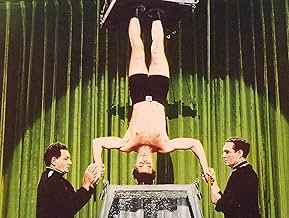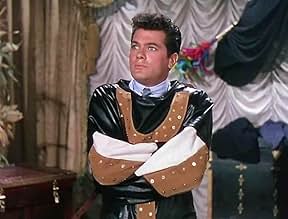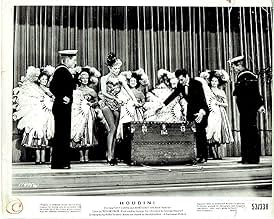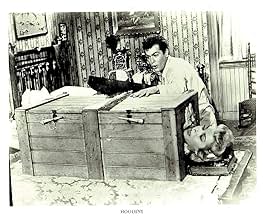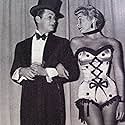AVALIAÇÃO DA IMDb
6,8/10
3,9 mil
SUA AVALIAÇÃO
Tony Curtis tem um desempenho vitorioso como o grande Houdini, o empenhado artista de circo que se tornou o mágico e artista de fuga mais cativante do mundo.Tony Curtis tem um desempenho vitorioso como o grande Houdini, o empenhado artista de circo que se tornou o mágico e artista de fuga mais cativante do mundo.Tony Curtis tem um desempenho vitorioso como o grande Houdini, o empenhado artista de circo que se tornou o mágico e artista de fuga mais cativante do mundo.
- Direção
- Roteiristas
- Artistas
John Alban
- Restaurant Patron
- (não creditado)
John Albright
- Audience Member
- (não creditado)
Eric Alden
- Sailor
- (não creditado)
Fred Aldrich
- Bouncer
- (não creditado)
Elsie Ames
- Entertainer
- (não creditado)
- Direção
- Roteiristas
- Elenco e equipe completos
- Produção, bilheteria e muito mais no IMDbPro
Avaliações em destaque
Tony Curtis is almost always good in whomever he plays, and he was fascinating in here as the famous magician "Harry Houdini." Curtis had a number of good roles in his prime. Speaking of "prime," Janet Leigh didn't look too bad in her prime, either: a very pretty lady.
I don't know how accurate this biography was, but I do know that this movie should have been longer. I usually say the opposite about films, but in this case, I would like to have seen more details about his life and death. His failure to communicate with dead - Houdini's misguided belief - wasn't discussed much.
I guess there were a couple of more modern-day films on Houdini, but they must not have been anything much since I never heard about them. Too bad, because a good re-make of this movie might be something to see.
I don't know how accurate this biography was, but I do know that this movie should have been longer. I usually say the opposite about films, but in this case, I would like to have seen more details about his life and death. His failure to communicate with dead - Houdini's misguided belief - wasn't discussed much.
I guess there were a couple of more modern-day films on Houdini, but they must not have been anything much since I never heard about them. Too bad, because a good re-make of this movie might be something to see.
Spectacular biography of famed escape artist dealing with the Great Houdini. At the outset, he had little success he performed in dime sideshows, and even doubled as "The Wild Man .At the same the young Houdini (Tony Curtis) enters into a passionate affair with a beautiful girl. Harry met fellow performer Wilhelmina Beatrice (Bess) Rahner (Janet Leigh), whom he married. Bess acts in the shows , which became known as "The Houdinis." For the rest of Houdini's performing career, Bess would work as his stage assistant. During Harry Houdini's tour of Britain in 1926, the master escapist realizes a highly publicized show. Within months, he was performing at the top vaudeville houses in the country. In 1900, his manager arranged for Houdini to tour Europe. After some days of unsuccessful interviews in London, Houdini managed to interest a manager of the Alhambra Theatre. He gave a demonstration of escape from handcuffs at Scotland Yard, and succeeded in baffling the police so effectively that he was booked at the show.
It's a story with Harry Houdini, arguably the greatest illusionist and escape artist of our time. This is a mostly fictionalized biopic of Houdini's life, was made. It contains thrills, suspense , emotions, a romantic story and is quite entertaining . This film, well played by Tony Curtis and Janet Leigh, has contributed, in part, to several misconceptions about Houdini's life. For example, it portrays the cause of Houdini's death to be the magician's failure to escape from the Chinese Water Torture Cell. (Curtis's Houdini agrees to seek medical attention "when the tour is over.") Houdini actually developed the Chinese Torture Cell trick fourteen years before he died and performed it numerous times. The motion picture is finely directed by Geoorge Marshall.
The picture is partially based on facts , the real events were the following : Houdini's "big break" came in 1899 when he met manager Martin Beck in rural Woodstock, Illinois. Impressed by Houdini's handcuffs act, Beck advised him to concentrate on escape acts and booked him on the Orpheum vaudeville circuit. Within months, he was performing at the top vaudeville houses in the country. In 1900, Beck arranged for Houdini to tour Europe. After some days of unsuccessful interviews in London, Houdini managed to interest Dundas Slater, then manager of the Alhambra Theatre. He gave a demonstration of escape from handcuffs at Scotland Yard, and succeeded in baffling the police so effectively that he was booked at the Alhambra for six months.Houdini became widely known as "The Handcuff King." He toured England, Scotland, the Netherlands, Germany, France, and Russia. In each city, Houdini would challenge local police to restrain him with shackles and lock him in their jails. In many of these challenge escapes, Houdini would first be stripped nude and searched. In Moscow, Houdini escaped from a Siberian prison transport van. Houdini claimed that, had he been unable to free himself, he would have had to travel to Siberia, where the only key was kept. In Cologne, he sued a police officer, who alleged that he made his escapes via bribery. Houdini won the case when he opened the judge's safe (he would later say the judge had forgotten to lock it). He would free himself from jails, handcuffs, chains, ropes, and straitjackets, often while hanging from a rope in plain sight of street audiences. Because of imitators, on January 25, 1908, Houdini put his "handcuff act" behind him and began escaping from a locked, water-filled milk can. The possibility of failure and death thrilled his audiences. Houdini also expanded repertoire with his escape challenge act, in which he invited the public to devise contraptions to hold him. Brewers challenged Houdini to escape from a barrel after they filled it with beer in Scranton, PA and other cities. Many of these challenges were prearranged with local merchants in what is certainly one of the first uses of mass tie-in marketing. Rather than promote the idea that he was assisted by spirits, as did the Davenport Brothers and others, Houdini's advertisements showed him making his escapes via dematerializing, although Houdini himself never claimed to have supernatural powers.Poster promoting Houdini taking up the challenge of escaping an "extra strong and large traveling basket" . In 1912, Houdini introduced perhaps his most famous act, the Chinese Water Torture Cell, in which he was suspended upside-down in a locked glass-and-steel cabinet full to overflowing with water. The act required that Houdini hold his breath for more than three minutes. Houdini performed the escape for the rest of his career. Despite two Hollywood movies depicting Houdini dying in the Torture Cell, the act had nothing to do with his death. Throughout his career, Houdini explained some of his tricks in books written for the magic brotherhood. In Handcuff Secrets (1909), he revealed how many locks and handcuffs could be opened with properly applied force, others with shoestring. Other times, he carried concealed lockpicks or keys, being able to regurgitate small keys at will. When tied down in ropes or straitjackets, he gained wiggle room by enlarging his shoulders and chest, moving his arms slightly away from his body, and then dislocating his shoulders.For most of his career, Houdini was a headline act in vaudeville. For many years, he was the highest-paid performer in American vaudeville. One of Houdini's most notable non-escape stage illusions was performed at New York's Hippodrome Theater, when he vanished a full-grown elephant (with its trainer) from the stage, beneath which was a swimming pool. In the final years of his life (1925/26), Houdini launched his own full-evening show, which he billed as "3 Shows in One: Magic, Escapes, and Fraud Mediums Exposed".
It's a story with Harry Houdini, arguably the greatest illusionist and escape artist of our time. This is a mostly fictionalized biopic of Houdini's life, was made. It contains thrills, suspense , emotions, a romantic story and is quite entertaining . This film, well played by Tony Curtis and Janet Leigh, has contributed, in part, to several misconceptions about Houdini's life. For example, it portrays the cause of Houdini's death to be the magician's failure to escape from the Chinese Water Torture Cell. (Curtis's Houdini agrees to seek medical attention "when the tour is over.") Houdini actually developed the Chinese Torture Cell trick fourteen years before he died and performed it numerous times. The motion picture is finely directed by Geoorge Marshall.
The picture is partially based on facts , the real events were the following : Houdini's "big break" came in 1899 when he met manager Martin Beck in rural Woodstock, Illinois. Impressed by Houdini's handcuffs act, Beck advised him to concentrate on escape acts and booked him on the Orpheum vaudeville circuit. Within months, he was performing at the top vaudeville houses in the country. In 1900, Beck arranged for Houdini to tour Europe. After some days of unsuccessful interviews in London, Houdini managed to interest Dundas Slater, then manager of the Alhambra Theatre. He gave a demonstration of escape from handcuffs at Scotland Yard, and succeeded in baffling the police so effectively that he was booked at the Alhambra for six months.Houdini became widely known as "The Handcuff King." He toured England, Scotland, the Netherlands, Germany, France, and Russia. In each city, Houdini would challenge local police to restrain him with shackles and lock him in their jails. In many of these challenge escapes, Houdini would first be stripped nude and searched. In Moscow, Houdini escaped from a Siberian prison transport van. Houdini claimed that, had he been unable to free himself, he would have had to travel to Siberia, where the only key was kept. In Cologne, he sued a police officer, who alleged that he made his escapes via bribery. Houdini won the case when he opened the judge's safe (he would later say the judge had forgotten to lock it). He would free himself from jails, handcuffs, chains, ropes, and straitjackets, often while hanging from a rope in plain sight of street audiences. Because of imitators, on January 25, 1908, Houdini put his "handcuff act" behind him and began escaping from a locked, water-filled milk can. The possibility of failure and death thrilled his audiences. Houdini also expanded repertoire with his escape challenge act, in which he invited the public to devise contraptions to hold him. Brewers challenged Houdini to escape from a barrel after they filled it with beer in Scranton, PA and other cities. Many of these challenges were prearranged with local merchants in what is certainly one of the first uses of mass tie-in marketing. Rather than promote the idea that he was assisted by spirits, as did the Davenport Brothers and others, Houdini's advertisements showed him making his escapes via dematerializing, although Houdini himself never claimed to have supernatural powers.Poster promoting Houdini taking up the challenge of escaping an "extra strong and large traveling basket" . In 1912, Houdini introduced perhaps his most famous act, the Chinese Water Torture Cell, in which he was suspended upside-down in a locked glass-and-steel cabinet full to overflowing with water. The act required that Houdini hold his breath for more than three minutes. Houdini performed the escape for the rest of his career. Despite two Hollywood movies depicting Houdini dying in the Torture Cell, the act had nothing to do with his death. Throughout his career, Houdini explained some of his tricks in books written for the magic brotherhood. In Handcuff Secrets (1909), he revealed how many locks and handcuffs could be opened with properly applied force, others with shoestring. Other times, he carried concealed lockpicks or keys, being able to regurgitate small keys at will. When tied down in ropes or straitjackets, he gained wiggle room by enlarging his shoulders and chest, moving his arms slightly away from his body, and then dislocating his shoulders.For most of his career, Houdini was a headline act in vaudeville. For many years, he was the highest-paid performer in American vaudeville. One of Houdini's most notable non-escape stage illusions was performed at New York's Hippodrome Theater, when he vanished a full-grown elephant (with its trainer) from the stage, beneath which was a swimming pool. In the final years of his life (1925/26), Houdini launched his own full-evening show, which he billed as "3 Shows in One: Magic, Escapes, and Fraud Mediums Exposed".
The story of master magician Harry Houdini (18741926) becomes a glossy star-vehicle for Tony Curtis in the lead--and though the facts of Houdini's life are lumped right together with the Hollywood dross (as if this movie magazine-styled spread were one big true-life story), one is drawn in by Curtis' apparent commitment to the role. Director George Marshall stages some exciting set-pieces and a nice romance ensues between Tony's Houdini and assistant Bess, played by Curtis' real-life spouse Janet Leigh (doing appealing work). Philip Yordan adapted Harold Kellock's book, and the results are (surprisingly) entertaining despite all the requisite corn and clichés. **1/2 from ****
..since he is and has been an amateur magician, Curtis was perfect to portray Houdini, the master magician and above all.. the master escape artist! A beautiful technicolor film that has the atmosphere of vaudeville and showbiz of the day, it invokes the mystery of the great showman's lifestyle and his unusual death on Halloween. Janet Leigh,as Houdini's wife, Bess, adds to the fun... and for those that love magic and magicians, this will satisfy you. The early life, the escapes from ropes, chains and jail cells the world-over, from the icy waters of rivers and lakes, it is all here. Slicked up naturally not so much to educate us, but to entertain.. ...!
By the early 1900s, the extraordinary Houdini earned an international reputation for his theatrical tricks and daring feats of extrication from shackles, ropes, handcuffs, and Scotland Yard's jails...
The film depicts Houdini's memorable escape from any pair of handcuffs produced by the audience; the outdoor exhibition, when he allows himself to be hanged upside down from his ankles, suspended from the roof of a high building, in a strait jacket; and, the dramatic act, when he accepts to be shackled with irons and placed in a box that is locked, roped, and submerged in frozen waters...
The film also exposes Houdini's campaign against mind readers, fraudulent mediums and others who claim supernatural powers... Houdini shows a passionate talent for escapology and the film did much to create the 'Water Torture Cell' illusion...
With his pretty-boy looks, Tony Curtis handles the title role with passionate skill... His energetic performance, as the talented and motivated magician, is very good...
With good period atmosphere, but with more attention to romance than to interesting detail, the film is quite enjoyable and colorful...
Janet Leigh does a great job as Houdini's faithful wife...
The film depicts Houdini's memorable escape from any pair of handcuffs produced by the audience; the outdoor exhibition, when he allows himself to be hanged upside down from his ankles, suspended from the roof of a high building, in a strait jacket; and, the dramatic act, when he accepts to be shackled with irons and placed in a box that is locked, roped, and submerged in frozen waters...
The film also exposes Houdini's campaign against mind readers, fraudulent mediums and others who claim supernatural powers... Houdini shows a passionate talent for escapology and the film did much to create the 'Water Torture Cell' illusion...
With his pretty-boy looks, Tony Curtis handles the title role with passionate skill... His energetic performance, as the talented and motivated magician, is very good...
With good period atmosphere, but with more attention to romance than to interesting detail, the film is quite enjoyable and colorful...
Janet Leigh does a great job as Houdini's faithful wife...
Você sabia?
- CuriosidadesA talented amateur magician, Tony Curtis performed most of his own tricks in this film.
- Erros de gravaçãoWhen the Houdinis and the reporter are being driven to the séance, the same rear projection loop is continually run in the car's back window, repeatedly showing the same background traffic, with the splice where the loop begins plainly visible each time.
- Citações
Harry Houdini: I hadn't prepared anything for tonight, but perhaps I have something that will amuse you. So if you'll get a couple of broomsticks, I'll get my wife - and we'll see what we can do.
- ConexõesEdited into Magic with the Stars (1982)
- Trilhas sonorasPerpetuum Mobile, Op. 257 (Perpetual Motion)
(uncredited)
Music by Johann Strauss
Played during the straitjacket contest
Principais escolhas
Faça login para avaliar e ver a lista de recomendações personalizadas
- How long is Houdini?Fornecido pela Alexa
Detalhes
- Tempo de duração1 hora 46 minutos
- Cor
- Proporção
- 1.37 : 1
Contribua para esta página
Sugerir uma alteração ou adicionar conteúdo ausente

Principal brecha
By what name was Houdini, o Homem Miraculoso (1953) officially released in India in English?
Responda

